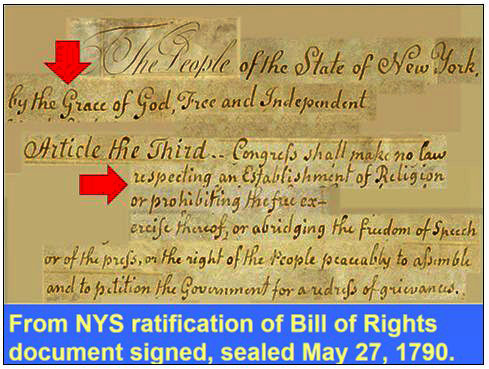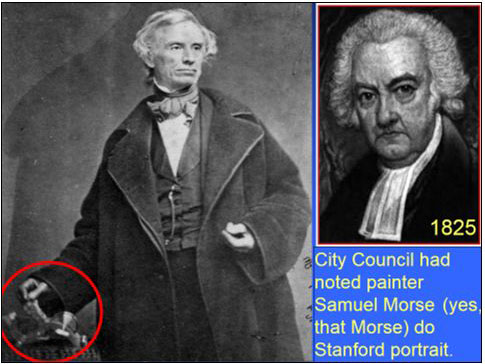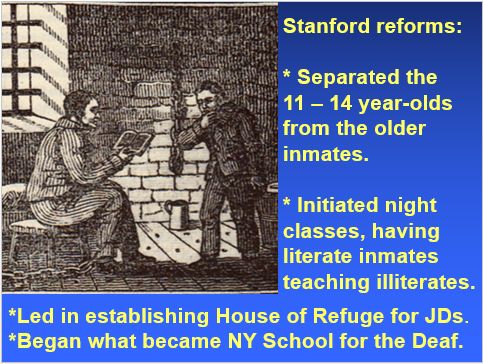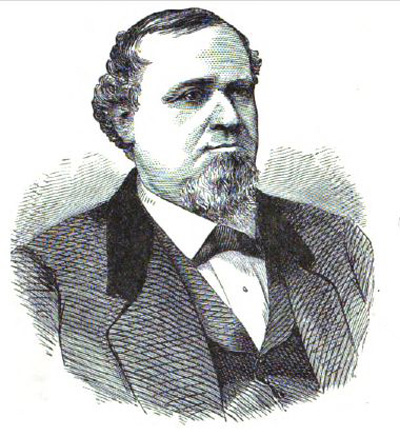|
Part 3 of a 3-part web version of a paper presented Nov. 15, 2013 at Researching New York 2013 by correctionhistory.org webmaster. Clicking lower case Roman numerals in Parts I and II accesses respective endnotes in Part III. Clicking that citation's numeral in Part III returns you to your place in Part I or II. A list of links
to access any of the 3 parts appears at bottom of each page.
REV. JOHN STANFORD: U.S. & NY’s 1st STATE-HIRED &
PAID PRISON CHAPLAIN WASN’T PASSIVE Stanford’s 1812 state prison chaplaincy appointment has particular significance because it happened about a generation after adoption of the born-in-NY Bill of Rights (with its religious liberty protections). NY authorities saw no conflict with the First Amendment. His being hired marks one of the new nation’s first “accommodations” bridging the supposed divide between church and state.
It’s worth noting that the 1790 document proclaiming NYS’s adoption of the Bill of Rights begins with the phrase, The People of the State of New York, by the Grace of God, Free and Independent . . . .” To this day that phrase still appears atop various NYS’ legal documents.
[i]
Rev. Charles George Sommers, Memoir of the Rev. John Stanford, D.D.:
Late Chaplain to the Humane and Criminal Institutions in the City of
New-York, Swords, Stanford & Co. 1835, (Google
eBook), Pages 309 – 311. Despite its title, this is less an
autobiography than a biography written by the Sommers quoting very
extensively from Rev. Stanford's journals, sermons, letters and other
writings. [ii]
Justice Ruth Bader Ginsburg, Opinion of the Court, CUTTER V.
WILKINSON (03-9877) 544 U.S. 709 (2005) 349 F.3d 257, Cornell
University Law School, Legal Information Institute, web
site, [iii]
Jennifer Graber, The Furnace of Affliction: Prisons & Religion in
Antebellum America, University of North Carolina Press, 2011, Page
54. (A preview version is on Google Books but have a publisher’s review
copy.) [iv]
Ibid, Pages 182-183. [v]
David Benedict, A General History of the Baptist Denomination in
America and Other Parts of the World, Lewis & Colby, New
York, 1848, (Google eBook), Page 457 [vi]
Op. Cit., Sommers, Page 41. [vii]
Ibid, Pages 108-109. So far my research into any Stanford interaction in
New York with Catholic clergy or Catholic churches (or with rabbis or
Jewish congregations has come up empty. But Page 285 of Sommers features a
fascinating letter to Stanford from the prominent Catholic signer of the
Declaration of Independence, Charles Carroll of Carrollton, responding to
Stanford’s earlier letter to that Founding Father and expressing agreement
with the chaplain’s views on religious liberty. In 1825 as Stanford entered his 7th decade of life, an appreciative NYC paid him tribute by having his portrait painted and placed on display in the dinning room of Bellevue Hospital. It was an appropriate location because the hospital was part of a complex of institutions --charitable and correctional – which he continued to service until infirmities of age forced him eventually to curtail his rounds.
[viii]
Right Rev. George Upfold, A Brief Sketch of the Life of the Rev. John
Stanford, D.D. Page xii in the 1855 edition of Rev. John
Stanford’s Aged Christian’s Companion: A Variety of Essays for the
Improvement, Consolation and Encouragement of Persons Advanced in Life,
Stanford & Swords, New York. (Google eBook) [ix]
Op. Cit., Garber, Pages 52-54. [x]
Op. Cit., Sommers, Pages 111-117. [xi]
Op. Cit., Upfold, Page xvi. [xii]
Ann Fabian,The Unvarnished Truth: Personal Narratives in
Nineteenth-Century America, University of California Press, 2000,
Page 72. (Google Books Preview) [xiii]
Op. Cit., Sommers. Page 109. [xiv]
Ibid, Page 274. Though not noted in the main text above, Stanford wrote
an 1815 article as “Americus” for the Mercantile Advertiser in
which he formally proposed that the merchant community lead a campaign to
establish a “Public Marine School.” Sommers devotes Pages 254-257 to the
reverend’s plan, including a letter from Commodore Perry agreeing that
“court boys” should not be excluded from seamanship training which had
been proposed by the naval hero. He too thought, like Stanford, that such
youths could benefit from nautical schooling at sea. [xv]
Pages 16-17, 47th Annual Report of the Managers of
theSociety for Reformation of Juvenile Delinquents, 1867,
Documents of the Assembly of the State of New York, Volume 4, No.
51. (Google Books) I believe I first seriously considered Stanford
as a subject for more extensive treatment on the correctionhistory.org web
site (and therefore research) when I encountered his interest in NYC
sponsoring or operating a nautical training ship for vagrant youths. I
came across him in researching the saga of NYC’s first school ship, the
Mercury, operated out of Hart Island as an ocean-going extension of
its industrial/reform school. See Part 2 of 8 parts and Part 4 Stanford simply doesn’t fit the clerical stereotype of a parson passively accepting the institutional regimes where his chaplaincy calling took him. He did indeed challenge the system at the Almshouse that wrote off deaf inmates housed there as unteachable. He did challenge the prison mixing child inmates in with the adults. He did challenge the whole idea of imprisonment of street children instead of providing them with a House of Refuge. He did challenge the prison’s lack of any schooling for its many illiterate inmates.
True, Stanford’s challenging the city and its institutions wouldn’t satisfy history revisionists’ who reject 18th and 19th Century reformers for not being more like modern militant confrontational activists. From within the system, he challenged it to do better for those whom it was supposed to serve.
[xvi]
Unlike all the previous end notes above, this one is not tied to any
specific quotation, of which this paper already has more than a
sufficient number. Rather this end note points to two excellent sources
supporting the paper’s contention that Stanford, far from being the
stereotypical passive prison parsons served up by modern scriptwriters,
frequently initiated and proposed improvements and reforms – in effect,
challenging the system to change: ·
W. David Lewis, From Newgate to Dannemora: The Rise of
the Penitentiary in New York, 1796 – 1848, Cornell University Press,
1965. Page 39, about the “selfless labors … of the elderly clergyman” who
initiate night classes for Newgate inmates, sometimes using literate
prisoners as tutors for the illiterates. He also stated a library for
inmates but the prison administration shut it down after books came back
damaged. Page 47, about his advocating unsuccessfully for setting up an
honor group of inmate trustees. I have extended excerpts from the book posted
on the correctionhistory.org, with both the publisher and late author’s
permission. ·
Edwin G. Burrows and Mike Wallace, Gotham: A History
of New York City to 1898, Oxford University Press, 1999, Page 385,
about his and clergy colleague Ely’s reports on public institutions
prompting establishment of the Society for Supporting the Gospel Among the
City of NY; Page 494, about Stanford’s refusal to join with those
advocating ending aid to the poor whom, claimed the Society for Prevention
of Pauperism, had only themselves to blame for their situation; Page
501-502, about Stanford and House of Refuge; Page 506, about Stanford at
James Reynolds’ execution. ### |



